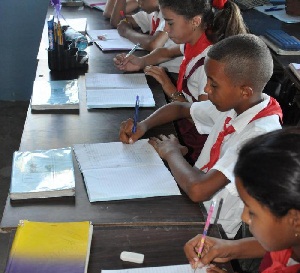 At this time, Cuba’s Ministry of Education is undertaking its third round of efforts to perfect the national school system, a process which, of course includes education in rural areas.
At this time, Cuba’s Ministry of Education is undertaking its third round of efforts to perfect the national school system, a process which, of course includes education in rural areas.
As part of the current updating, and taking into consideration the characteristics of non-urban areas, new strategies have been charted to better match ways of teaching with the context in which students learn.
Specialists with extensive experience are working to maintain the quality and rigor of Cuban schools. One of these is Humberto Marrero Silva, a PhD in Pedagogical Sciences working at the University of Holguín.
What new proposals for rural, multi-grade elementary schools are being made during this round of improvement efforts?
Beginning with this round of improvement efforts, working with a single class is going to be extended throughout the country. At this time, some teachers, who have different combinations of grades, present their lessons with spontaneous, direct attention, in an independent fashion for different grades – that is they are not always standing in front of the group for the 45 or 60 minutes that the activity might last.
The single class concept proposes that in the rural sector there be but one classroom for whatever combination of grades that exists. The teacher must have training, and we are working to achieve this so they are capable of directing this process in a simultaneous fashion for all grades, at the same time.
Abilities are more developed, greater effort is demanded of the teacher, but results better reflecting the children are obtained, on a par with those achieved in other areas of the country.
We are not going to say that the single classroom is the magic wand which is going to resolve all problems in the rural sector, specifically the multi-grade class, but, yes, it will contribute greatly in that teachers with six grades will not need to prepare six lessons, but rather that, with only one, they can address the entire group during the class period, and all students will know what is expected in accordance with their development.
When will this experience be extended across the system?
There are already several provinces in the country which are implementing different parts of this new focus. This is a task a group of authors from the rural sector has been working on since 2011. The way used to generalize it has been through workshops in the rural sector, held annually in different regions.
It has been used experimentally in different schools, and from these we have obtained results which are showing us this is the strategy we must adopt, so that the teaching-learning process in these contexts produces the outcomes we need.
On the basis of our model of an elementary school, be it rural or urban, but taking into consideration each one of these academic groups, up to 57 multi-grade combinations can be created.
Already placed in all Cuban schools are two volumes of the book La escuela primaria rural multigrado. Un acercamiento didáctico metodológico. (The rural multi-grade school. A didactic methodological approach)The first volume, of which I am among the authors, covers Spanish Language, and the second includes the subjects Mathematics, Natural Sciences, Cuban Geography, and “The World In Which We Live.” The theoretical and methodological foundation which sustains this third round of improvement efforts for the rural sector is in this book.
When the educational improvement process is discussed, emphasis is placed on what the teacher does. What must students in a multi-grade classroom do?
The first characteristic of this new concept of a single class is that, on the basis of integrated content and a common learning activity, the focus of attention is on the student, regardless of his or her level of development and maturity with regards to psychological processes.
All are going to develop abilities until they reach the moment when they are conscious of just how far they can go, and when they need help, be it from a classmate at their side or from the teacher.
It is a scaffolding of relations which develop among children at different levels of maturity. This is not going to be achieved immediately. It is a process; but I believe that it will not be long before one and all know just how far they can go when a common learning activity is presented in our multi-grade school groups.
In this situation, the multi-grade teacher becomes an active member of the academic group, but one who is going to be where they are most needed within this small grouping.
How are these modifications going to contribute to ensuring that similar results are achieved in both urban and rural schools?
The conditions and results will be maintained. For us, the principal problem will not be thinking about how the multi-grade student might be left behind. The principle challenge we have is that they not overtake others. The children in these academic groups are going to develop a series of abilities that could put them ahead of a child in a regular group. This is the principle challenge: not allowing this to happen.
(Granma)